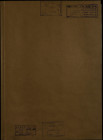Defence industry
The case of the privileges of the Armory Master Bertrand on the firearms of the new device invented
The case of the issuance of the 5-year privilege of St. Petersburg 3 Guilds to the merchant Sulov, with brothers, on the way invented by them
Letter from Yakov Stepanovich Perepelkin, owner of the cork factory in the city of Ryazan, D.I. Ilovaysky, dated May 21, 1905, describing a new type of submarine that he invented
Letter from Yakov Stepanovich Perepelkin, the owner of a cork factory in Ryazan, D.I. Ilovaysky on May 21, 1905 with a description of a new type of submarine he invented.
The case on the legislative proposal of members of the State Duma of the third convocation on the change in Article 176 of the Industry Charter, on the procedure for issuing privileges in the inventions in the regions of military and naval technology
According to the legislative assumption of members of the State Duma on the establishment of rules for the compulsory alienation of privileges for inventions and improvements in the field of military equipment in favor of the state
On the abolition of art.176 Industry Charter - On the procedure for issuing privileges for the inventions of defense significance
On issuing remuneration to some ranks of the Artillery Department of the Main Department of Shipbuilding of the Maritime Ministry and Guard Colonel Helvich for the invention of the sample fuse of 1913
Pyotr Gelvih (1873-1958), a Russian scientist of ballistics, Major General of Artillery (1940), Professor (1935), Doctor of Technical Sciences (1938), the Stalin Prize Laureate (1941). For a long time, he was a Professor at artillery schools. He was engaged in the development of artillery firing theory and wrote numerous scientific papers. Gelvih was the first to formulate the theoretical foundations for explosive remote dispersion. The state security authorities arrested him four times. He spent more than eight years in prison and was rehabilitated later.
On the issuance of remuneration of the family of the captain of 2-goranga K. F. Schultsov for the invention of the invention
Konstantin Shultz (1864-1904), a sailor, the 2nd Rank Captain. He is a student of Professor Alexander Popov and author of the mine "Schultz" exploder. He initiated the equipping of the Baltic Fleet ships with radio. Shultz participated in the Russian-Japanese War and died on the battleship "Petropavlovsk".
Letters of individuals in the name of a member of the State Duma of Kerensky A. F. with a proposal of inventions for defense needs
On awarding Assistant Mining Department of the Marine Ministry of Major General Pastukhov for the invention of the anti-mining network
Ye. A. Pastukhov (1863-?), a Major General, Assistant to the Head of the Mine Department of the Naval Ministry. In 1896 he graduated from the Mine Officer Class. In 1898 he became the Senior Flag Officer of the Headquarters of the Commander of the Pacific Squadron, received a Japanese order. For some reason, he did not participate in the "Bayan" voyage to the East. From 1904 he served in the Marine Technical Committee. In 1911 he took the position of Assistant to the Head of the Mine Department.
- Igor Sikorsky
According to the legislative assumption of members of the State Duma on vacation of funds for issuing a premium engineer I. I. Sikorskoye for the invention of the aircraft
Council of Ministers (1905-1917).According to the legislative assumption of members of the State Duma on the vacation of funds for issuing a premium engineer I. I. Sikorsky for the invention of the aircraft.Russian air bogatyri I. I. Sikorsky
Finn, Konstantin Nikolaevich (1878-1956).Russian Bogatyri I. I. Sikorsky.Belgrade: [b.and.], 1930.














Jacob Bertrand (? - 1849 (?), a court and the Naval Department gunsmith. He launched a business in Russia in 1830. In 1835–1840 he worked with Javale. At the 1835 Moscow Exhibition, he exhibited guns and pistols; at the St. Petersburg exhibition in 1849 - hunting rifles, a carbine and a "large double-barreled gun made for placing on yacht deck". In 1836-1848 the naval forces tested his breech-loading rifle. In 1844 he made a gun with a silver decoration for the Grand Duke Mikhail Nikolaevich (cost 300 rubles). The State Hermitage Museum and the State Historical Museum keep weapons of his production.